Japan
Wood Products Prices
Dollar Exchange Rates of 25th
April
2020
Japan Yen 107.48
Reports From Japan
Bank of Japan pumps money into the economy ¨C says
the taps will stay open
The International Monetary Fund has said that because it
is unlikely the global disruption of demand caused by the
pandemic will subside in a short time they anticipate the
export dependent Japanese economy could contract by
over 5% this year, a drop which would be worse than
during the 2008/9 global financial crisis.
The Bank of Japan (BoJ) clearly agrees with the IMF as on
27 April it announced a massive expansion of monetary
stimulus, the second in a month, to aid corporate Japan
and also finance the government's emergency package
which now stands at yen 117.1 trillion after the
government approved a revised supplementary budget for
fiscal 2020.
The increase from the initial package worth yen 108.2
trillion comes after a decision to offer a cash handout of
yen 100,000 to every person in Japan. The decision by the
Bo follows those of other central banks that have
announced similarly huge support for their economies and
nationals.
SMEs can only survive if lock-down ends in a few
months
After declaring a month-long state of emergency in the
seven prefectures with the fastest pace of infection spread
a nationwide state of emergency has been declared in
Japan due to the country¡¯s worsening coronavirus
outbreak. This decision from the central government paves
the way for regional governments to launch local
campaigns urging everyone to stay off the streets.
The state of emergency will remain in force until 6 May
but media reports speculate that it is increasingly likely
that the emergency will be extended beyond 6 May when
the current regulation expires. After the recent surge in
corona virus cases in Tokyo experts warned that the
emergency medical facilities are close to collapsing.
The Japan Times, reporting on a survey conducted by NN
Life Insurance in late March (i.e. before the nationwide
state of emergency) says 60% of small and midsize
companies say they can survive if the pandemic ends in
the next few months.
Around 16% said their business can survive until the end
of May but 7% said they can only make it through the end
of March.
There are reports that the government is considering a
support package for small businesses that were
temporarily idle during the current state of emergency.
See:
https://www.japantimes.co.jp/news/2020/04/27/business/economy-business/japan-small-midsize-firmspandemic/#.XqfDOLYzbIU
Companies looking for legal ways to terminate nonpermanent
workers
The state of emergency triggered by the corona virus has
resulted in a surge in non-permanent workers being laid
off. Economists are forecasting that one million newly
unemployed could be added to statistics, a figure higher
than during the 2008-2009 global financial crisis.
The first response of many small companies was to
consider temporary business suspension but recently the
mood among companies has changed with many seeking
ways to dismiss employees. Labour unions in Japan have
pointed to a trend to shortening temporary employees¡¯
contracts in preparation for layoffs.
The April consumer confidence survey showed a steep
decline in all individual indices. The index for general
household sentiment dropped to the worst ever seen in the
past two decades.
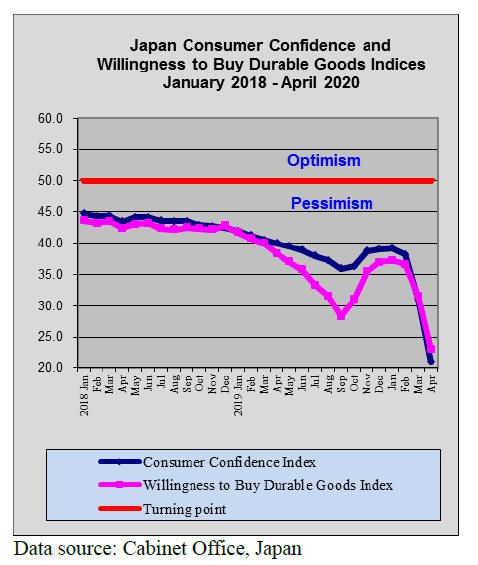
Yen remarkably steady against the US dollar
The news that the BoJ will expand its monetary easing to
counter the impact on the economy from the corona virus
outbreak surprisingly failed to drive the yen down against
the US dollar, it barely moved and remains around yen
107 to the dollar.

Better than expected housing starts
Japan¡¯s housing starts for March fell almost 8% year on
year but this was significantly better than the forecasts
made in February.
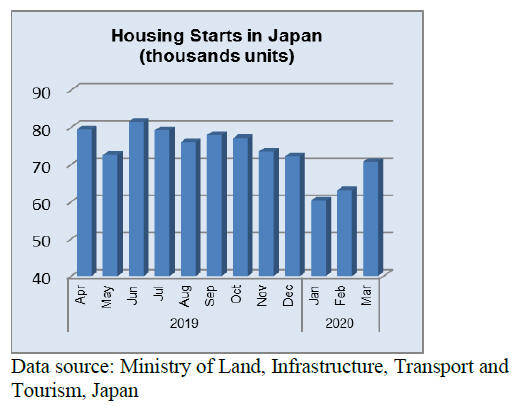
Import update
Wooden door imports
The sharp drop in wooden door (HS441820) imports was
little surprise. Year on year, the value of wooden door
imports dropped over 40%. There was also a 40% drop
compared to levels in Janaury before the impact of the
pandemic started to bite.
As in previous months four shippers accounted for over
90% of Japan¡¯s February 2020 imports of wooden doors
(HS441820). The main shipper was China which
accounted for 43% of all door imports. This was sharply
down on the 65% contribution to imports in January.
Shippers in the Philippines secured a greater market share
in February accounting for 35% of imports, up from the
19% in January. The other two main shippers were
Indonesia and Malaysia both of which saw a slight rise in
shipments in February.
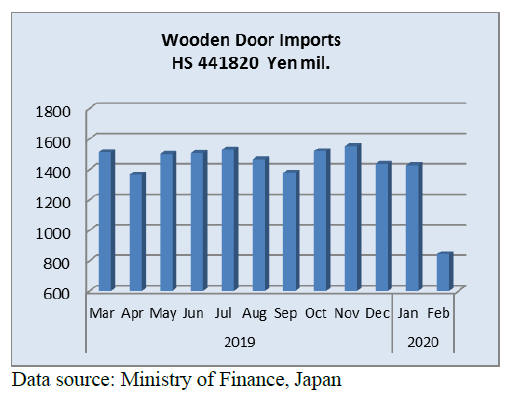
Wooden window imports
Mirroring the trend with door imports, the value of Japan¡¯s
imports of wooden windows (HS441810) also fell sharply
in February. Year on year, February imports dropped
around 36% and month on month there was a slightly
faster decline.
In February four shippers, China, US, the Philippines and
Sweden, once again provided over 90% of the value of
Japan¡¯s wooden window imports. Manufacturers in China
accounted for 36% of February 2020 shipments of wooden
windows to Japan followed by the US (24%), the
Philippines (26%, up significantly from January
shipments) and Sweden (6%).
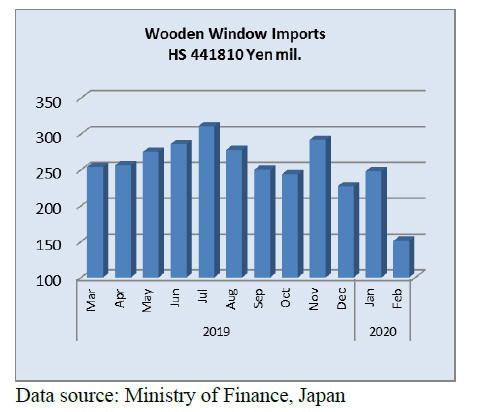
Assembled wooden flooring imports
Surprisingly, Japan¡¯s imports of assembled flooring
(HS441871-79) in February were not showing any signs of
decline. In fact, the cumulative value of imports for the
first two months of 2020 were sharply up on the same
period in 2019. As can be seen in the graphic on housing
starts there was a rise in starts in February which likely
drove up imports.
Of the four categories of flooring tracked, HS441875
made up around half of Japan¡¯s February imports with
most coming from Indonesia and Malaysia followed by
HS441879 which added a further 26% to the total value of
assembled wooden flooring imports. The main shipper of
HS441875 in February was France.
There were only small shipments of HS441871 in
February and imports of HS441874 were primarily from
manufacturers in China.
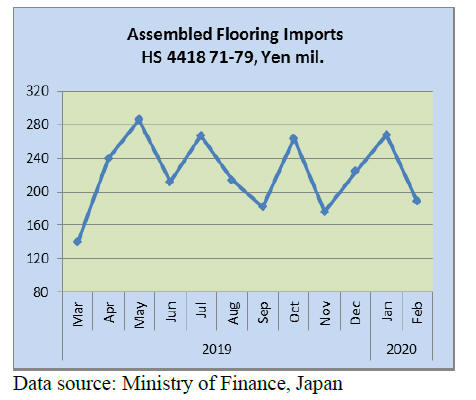
Plywood imports
Although in February Japan had not experienced a major
impact from the corona pandemic there were signs in the
construction and house building sectors that there was a
slow-down. Year on Year Japan¡¯s February imports of
plywood (HS441210-39) dropped 17% and compared to a
month earlier import volumes were down 12.5%.
There was a 50% decline in both year on year and month
on month plywood imports from China because many of
the mills in that country had ceased operation for the
Spring Festival which began on 25 January for 7days.
During the holidays workers return to their home
provinces but after the holidays and because of travel
restrictions many found they could not return to work
which hampered production.
Japan¡¯s imports from the main plywood suppliers,
Indonesia and Malaysia both experienced a 15% decline in
February.
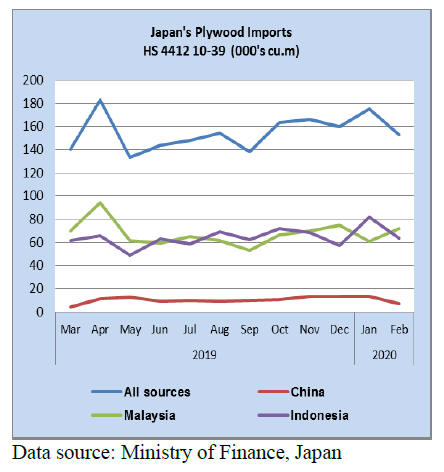 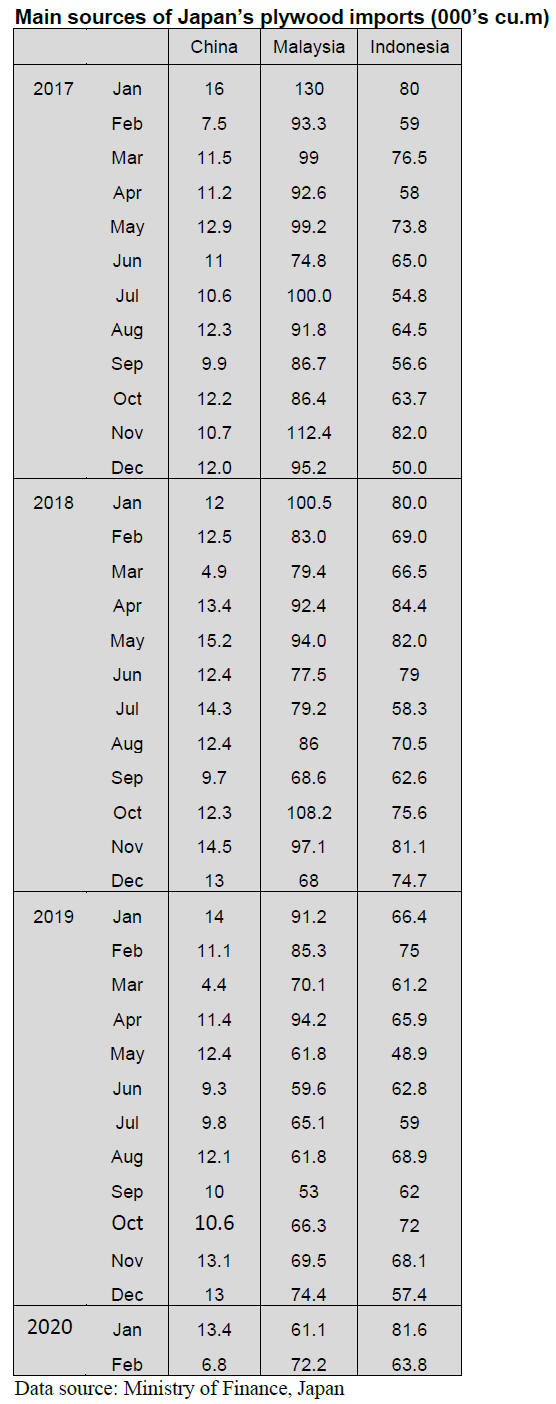
Trade news from the Japan Lumber Reports
(JLR)
The Japan Lumber Reports (JLR), a subscription trade
journal published every two weeks in English, is
generously allowing the ITTO Tropical Timber Market
Report to reproduce news on the Japanese market
precisely as it appears in the JLR.
For the JLR report please see:
http://www.nmokuzai.com/modules/general/index.php?id=7
Wood demand projection meeting
The Forestry Agency held wood demand projection
meeting on 23March. Average new housing starts
forecasted by 12 private think tanks are 847,000 units and
two think tanks forecasted less than 800,000 units. Major
house builders also reported that orders are declining and
it is general view that starts of detached unit would
continue severe by slowdown of economic condition
resulted by corona virus epidemic.
The forecast by think tanks is based on forecast in late
February and steep drop of stock market in March and
depressed economic condition by corona virus are not
reflected so next forecast would be much lower.
As to log export to China, by stagnating Chinese economy
and heavy rush of European beetle damaged logs into
China, the export volume would drop largely in 2020.
For domestic wood use, concern is how long corona virus
outbreak would last and how badly influence the economy
and general view is that the demand would be lower than
last year by dropping housing starts.
For logs to manufacture lumber, demand decrease would
be as bad as following year of Lehman shock in 2008 so
the second quarter supply would be down by 31.7% from
the same quarter last year and third quarter would be down
by 17.9%.
On imported logs and lumber supply, second quarter
would be down compared to last year. Particularly,
purchase of radiate pine logs and lumber from New
Zealand and Chile for March and April shipment would be
sharply down by 55.6%. For the third quarter, there are
views that the demand should recover with economic
stimulus measures and corona virus epidemic comes to an
end but other views are that the confusion would continue
so that the demand would keep dwindling.
Spreading plywood production curtailment
The first quarter demand is slow every year then outbreak
of corona virus rapidly cooled the market and plywood
prices have been dropping consistently.
Hayashi Plywood and Ishinomaki Plywood have
announced production cutback already by 15-20% and
now the largest manufacturer, Seihoku group announced
to curtail the production by 15-20% since April after the
12 mm 3x6 plywood prices dropped below 1,000 yen per
sheet delivered. Since March, low price offers started
spreading and with bearish future, buyers limit purchase
volume so the movement is stagnating.
Seihoku plans to stop further slide of the prices by quick
action to reduce the supply volume. It stops Saturday
working and overtime working.
May has many holidays and it is maintenance month so
the production will be down. How long it will continue
production cutback depends on demand and if the demand
stays weak, it will continue production curtailment
program.
Nisshin group (Shimane prefecture) announced to reduce
the production of long plywood and special size plywood
for house builders by 10% in April then 20% in May. The
group produces about 60,000 cbms of plywood a month.
Its inventory in January was 0.4 month but the inventory
of special items increased to three months so it decided to
reduce production of these items.
Key Tec Co., Ltd (Tokyo), plywood and LVL
manufacturer has started reducing the production of
structural softwood plywood by 15% since March 23.
Monthly production of 5,800 cbms will be reduced to
4,900 cbms. Shipment of structural LVL for housing is
also dropping. The monthly production is 4,000 cbms but
now it is 3,500 cbm.
Now almost all plywood manufacturers in Japan have
started production curtailment uniformly.
Impact of corona virus outbreak
In Malaysia, the Prime Minister announced stay-at-home
order to prevent further spreading of corona virus
infections but allowed operation of plywood
manufacturing in Sarawak, which is basic industry in
Sarawak. MDF plants are running through March 20 but
operation of chip plant and particleboard plant stopped. By
closure of government administration offices, it becomes
impossible to acquire legal timber harvest and log export
permit.
In Canada, the government ordered to ban entry of
foreigners except for Canadian citizens, diplomats and
airline workers. The international flights are allowed to
use only four cities of Montreal, Toronto, Vancouver and
Calgary.
Interfor, one of major lumber manufacturer in B.C.,
Canada, announced to reduce the production of all the
sawmills by 60% for two weeks. West Fraser announced
to reduce the production of sawmills in B.C. by 18% and
Southern pine mills in the U.S.A. by 24% for two weeks.
It also announced to reduce production of plywood by five
billion square feet per week. Both companies reviewed
and decrease capital investment plans in 2020.
In the U.S.A. new housing starts had kept climbing until
February then peaked off in the first week of March by
rapidly spreading corona virus infections so the lumber
market started plunging and SPF lumber prices dropped by
30% in one month. By local government restrictions,
business activities are largely hindered.
New Zealand government ordered people to stay home on
March 26 for four weeks. Export of logs and logging
would stop by this since workers are prohibited to go out.
Supply of radiate pine logs and lumber would drop
considerably. There is possibility that log and lumber
inventories at port or sawmills can be shipped out if the
government allows.
Negotiations on logs are disrupted. Export log prices for
China were about $105 per cbm C&F in late February but
the demand in China is coming back so the log prices are
$7-10 higher now with curtailed production by New
Zealand suppliers. Nelson Pine Industry, MDF
manufacturer, stops the operation for four weeks.
Tachikawa Forest Products (Hiroshima prefecture) has
been buying crating lumber from New Zealand. Now the
supplying mill in New Zealand requests Tachikawa to
provide letter to prove that the lumber is necessary for
emergency use since the lumber is used for crating food
and medical articles in Japan. The New Zealand mill attach
the letter for submitting to the government organization to
get permit for export.
Daiken announced to stop operation of two MDF plants in
New Zealand from March 23 to April 22.
Domestic logs and lumber
Log production is steady in March. Meantime movement
of lumber, plywood and laminated lumber is getting dull
day after day and plywood mills have started reducing the
production so log demand is dropping. Actually logs are
oversupplied so the market prices are weakening.
Sawmills have procured enough winter harvested logs,
which have longer life and have ample inventory then
from now on it is season when log quality deteriorate with
more moisture so mills are cautious in buying logs from
now on.
At the same time, lumber demand is dropping so mills¡¯ log
purchase is shrinking. Log market prices are 10,500-
12,000 yen per cbm on 3 meter post cutting cedar. 15,000-
16,000 yen on 3 meter post cutting cypress and 16,000-
17,000 yen on 3 meter sill cutting cypress. They are 2,000-
3,000 yen down from January.
Lumber demand was forecasted weak this year at
beginning of the year by decreasing housing starts after the
consumption tax increase since last October then since
March, corona virus infections started spreading and it
seems to prolong quite a while so lumber demand is much
severe than initial forecast.
March lumber sales by sawmills were almost the same as
March last year but April would be much worse. Actually
Tokyo lumber market has started skidding since March. 3
meter KD cedar 105 mm post prices are about 49,000 yen
and 120 mm is 44,000 yen, which are 1,000-2,000 yen
lower than last month.
Plywood
Movement of plywood is stagnant on both domestic and
imported plywood.
Domestic softwood plywood movement has started
slowing in March and the prices started sliding so the
manufacturers are quickly reducing the production.
Together with slowdown of demand, there are low price
sales before book closing month in March to secure sales
amount so the market is confused with unrealistic low
offers. The manufacturers stepped up production
curtailment before the market plunges into chaos.
New fiscal year started in April after last year¡¯s settlement
is over so the dealers have started new business plan but
unfortunately corona virus outbreak started in March so
nobody knows how serious and how long it would
influence the business. Actually business activities are
slowing down by the government order of stay-at-home.
Business is surely shrinking as movement of people is
restricted.
In Malaysia, the situation is the same as Japan. The
government is restricting various activities and plywood
mills in Sarawak are allowed to keep operating but log
harvest and transporting are restricted and various permits
are not obtainable since the government administrati
In Japan, inventory of imported plywood is getting low but
the demand has started declining by corona virus so there
is no shortage feeling although port warehouses report that
outgoing is now much more than incoming volume.
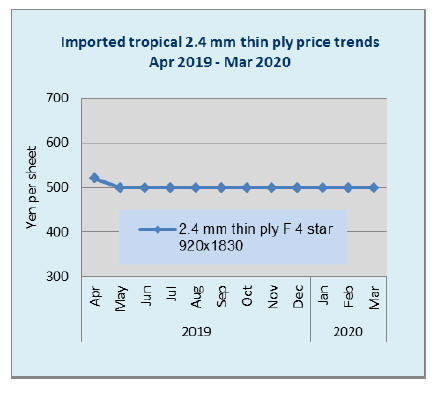

|